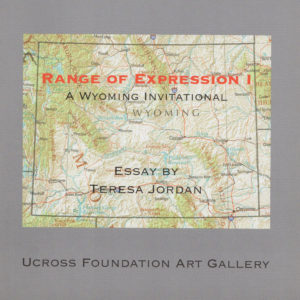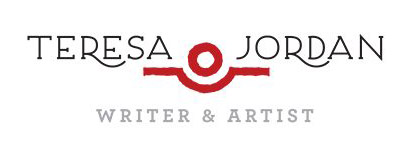The West We Know Now
By Teresa Jordan
Catalogue essay for Range of Expression I: A Wyoming Invitational, Ucross Foundation Art Gallery, 2007.
 Earlier today, I needed to apply a half-tone screen to a digital image in order to prepare it for the printer. I turned to PhotoShop, and as I looked through the program’s filters, I found one listed as “Wind.”
Earlier today, I needed to apply a half-tone screen to a digital image in order to prepare it for the printer. I turned to PhotoShop, and as I looked through the program’s filters, I found one listed as “Wind.”
For those even less familiar than I am with manipulating digital images, a filter applies an effect: you can”posteriz” a photograph, for instance, and reduce its color and contrast to a stylized graphic of black and white. You can make something look grainy or cracked or crystallized. There are even “Artistic” filters, which modify the image to look like “Watercolor” or “Loose Pastel” (not, I must say, very effectively.)
But “Wind.” Among the tasks I had hoped to initiate today was this essay, some comment on art and Wyoming. “Wind.” An artistic effect. I had never thought of it in quite that way before.
I was raised on a ranch in the Iron Mountain country of southeastern Wyoming. Wind dominated our lives for days and even weeks at a time, a fate we shared with people across much of the Great Plains. Once I lived for a year in the cookhouse of a neighboring ranch. The last people to inhabit it had been from the hills of Tennessee and I heard they were superstitious. They thought the house was under siege by ghosts, and each night they nailed themselves inside. They didn’t last long, and soon after I moved in I set about removing the hundreds of nails that porcupined the molding around the windows and doors. I found myself mumbling, “It takes all kinds.”
Then winter arrived and the wind whipped up. The drafty old house moaned like a pipe organ but more disturbing was what sounded like someone with a wooden leg clomping around the attic crawl space. I’m rational, but that spooked me. In time I came to believe that drafts picked up the loose square of plywood over the trapdoor in the bathroom and danced it around. I never caught it in action, but its placement seemed to change and at any rate a few screws ended the assault. Whatever the explanation, there was no question that wind “applied an effect.”
When we talk about art from a particular region, we often talk about a sense of place, but what is that, really? For a lot of people, the term “Western Art” is an oxymoron, conjuring certain predictable images of place involving Indians, cowboys, cavalry, and open country, often set in the 19th Century. These particular icons have spanned decades and been infinitely reproduced or modestly amended. Today they seem as clichéd as the Mona Lisa. And like the Mona Lisa, it’s easy to lose sight of their original freshness before placemats and wallpaper and pajamas turned them into banal commodities.
The romantic illumination of Thomas Moran’s gigantic “Cañon of the Yellowstone” (1872) or the wild drama of Frederic Remington’s “Bronco Buster” (1895): imagine seeing either one of these for the first time. And imagine, too, how the artists worked in thrall to what originally inspired them. These are works of obsession and also of invention as the act of creation passed through filters of engagement, imagination and desire. The very fact that these images seared themselves indelibly on so many succeeding generations speaks to the power of a particular place encountered at a particular time – in this case, when it was unseen and wild and attuned to a national mythos of exploration and conquest.
But this is new, too: A few years ago, I joined a neighbor fixing fence. We left the pickup window open and the radio cranked up loud; a Mozart flute concerto wove itself around the song of stretching barbed wire. My neighbor commented that Mozart could never have imagined such a scene: the idea of people out in a field, hundreds of miles from an orchestra or concert hall, leavening their daily labor with the beauty of his work was literally beyond conception.
These strange marriages of modern technology and ancient practice are historically unprecedented and they stand out in particular relief against the relative emptiness of the Great Plains. They redefine both space and solitude. Few of us drive across Wyoming without the company of satellite radio or a CD; the oil field roustabout has his Ipod; the rancher his cell phone. And at the same moment that we can fit a rock band or a political pundit into a wafer no bigger than a ginger snap, we create earth-eating machines more massive than barns, capable of rearranging the geology around us as effectively as an earthquake.
“Why,” wrote Wallace Stegner in 1964, “when so much of our literature (for example, Hemingway) strikes us as dealing with a present which has no past, should western books so often strike us as dealing with a past which has no present?” He referred to western literature; he could have been thinking of the region’s art. But that was 40 years ago. The West has changed and so has the art it inspires. This new art hasn’t abandoned its past but it layers it with both the present and the future.
PhotoShop applies the effect of wind by shifting pixels to one side or another. Painters can do the same by conjuring the slant of precipitation or the lean of a tree. But wind doesn’t have to find visible representation in a work to “apply an effect” on the artist who created it. Neither does the Ipod or the Komatsu 240-ton coal truck.
It would be accurate to view many of the works in this exhibit as postmodern. “Postmodern” is a catchall phrase, but to the degree that some of these artists reference fragmentation, pop culture and mass media; use a variety of methods and materials; and combine images from across time with a certain ironic distance, they work within their own temporal mythology as much as the 19th Century artists did. Still, I suspect that they are not so much postmodern cynics awash in the knowledge that nothing is new as they are spiritual travelers who know they can never step in the same river twice. I prefer to view these works — in their full spectrum from realism to abstraction — as more documentary than editorial. This is the West we know now, filtered through the passionate engagement of individual artists ignited by the power of place.
©2007 by Teresa Jordan
